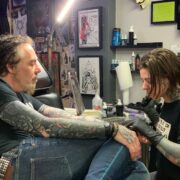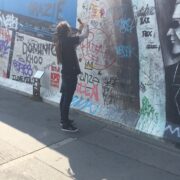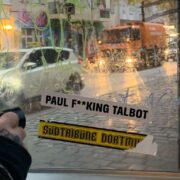This time I’d like to pull on your coat tails about something that came up in the world of Tattooing a little while ago, TattooGate.
But before I get into that I want to tell you a little story. Now, bear with me, because this will relate to my point in this column. I promise!
I went to see Post Malone recently. I’d never been to a gig of that kind having only experience ‘traditional’ rock music presented in the age old, excepted fashion. To be honest with you I wasn’t sure if Post Malones music would translate into a live setting. It is – afterall – one man on stage singing to a playback. I had no idea what I was about to witness.
ROCK ‘N’ ROLL IS DEAD?
The music industry has undergone significant changes in recent years. The rise of streaming platforms has caused the fragmentation of popular music genres. This has led to a broader diversity of musical styles and genres in the mainstream. And it’s in these genres that we can find the spirit of Rock ‘n’ Roll. Modern electronic music is more rebellious and prepared to mix and match genres however it feels. It’s not concerned with ‘how we used to do it’ it concentrates on new ways to do it today. It uses all the tools of 21st century life and presents itself to its audience in a way that they want to be entertained. It doesn’t blindly stick to ‘tried and true’ formulas and that’s the reason that it has risen and eclipse ‘old time’ Rock ‘n’ Roll.
Take a look at the lineup of the average Rock Festival and you’ll all to often see that the headliners are all in their 60’s. Having had their heyday in the 80’s and 90’s. You would think that – at some point – in the last 40 years that a band would have come along that was good enough to topple the giants and take the top spot, but no.
It’s my opinion that the problem rock music is facing is that it has allowed itself to stagnate. The transition from Vinyl and tapes to CD’s to streaming hasn’t been easy for rockers. Add to this that listeners now consumed music by song and not by album, often not even knowing the artists name and the unwillingness of bands to step away from the accepted ‘make and album, release, tour, start again’ business models of the 80’s rock heyday and it becomes easy to see why – in the modern world – a rockbands marketing strategy and business model look old fashioned. Rock ‘n’ Roll is dead, it has allowed itself to stagnate.
STAGNATION
The symptoms of stagnation in any artform are easy to spot. The decline in creativity, innovation, and overall relevance come first folled by a lack of new ideas, excessive reliance on established formulas and resistance to change and experimentation. Is this starting to sound familiar yet?
In the context of music, if a particular genre or style of music stagnates, it becomes predictable and formulaic. Artists within that genre might produce music that sounds repetitive or derivative, lacking the freshness and originality that initially made the genre appealing. As a result, audiences may lose interest, and the genre’s popularity and cultural impact may diminish.
Stagnation can also lead to the emergence of new subgenres or the blending of different styles, resulting in fresh and innovative approaches. This cross-pollination can bring about exciting developments and help prevent complete stagnation but it can also lead to feeling that the genre is just circling the drain and that it’s only a matter of time before someone pulls the plug.
But stagnation is not necessarily permanent. Art forms, including music, have the potential to rejuvenate and reinvent themselves. But first they have to accept the truth that change is the only way forward. New artists, movements, or technological advancements can breathe new life into a stagnant art form, but only if the gatekeepers get out of the way. And it’s the gatekeepers who stand to lose out. Often they represent and make their money from ‘the old way’. Maintaining the status quo is their business model. Change creates opportunities for others and we can’t have that, right?
So Rock music hasn’t died. It’s been allowed to stagnate to the point of irrelevance. Hell! they even have ‘rock’ bands on the Eurovision Song Contest theses days and if that’s not a sign that it’s time for a change then I don’t know what is.
My point? Any art form that stagnates will die. As our beloved art form – Tattoo – tries to reinvent itself for the 21st century (and the demands that come with) we will inevitably see people getting it wrong. But that’s no reason to stop trying to reinvent.
TATTOOGATE
I sure you’ll all have read enough about the most recent tattoogate to negate the need for me to regurgitate it here. By the time you’re reading this we’ll probably have had a couple more. Because, lets face it, we do love to gossip. So I’m not going to go into it in any great detail as I have no interest in rubbishing fellow artists or clients. I will, however, try to give you my overview of what mistakes were made and the lessons we can all learn from them.
And my overview is that the situation arose simply because someone tried to apply a new business model to tattooing but failed to correctly implement all the steps. This led to a disappointed client feeling ripped of, a viral Tik-Tok video and a burning stake wielding internet mob looking for a witch to burn – all standard stuff really, just a regular Tuesday in the interweb…
Before I put my toe into what is probably the stone cold bath waters of a dead controversy and explain why we actually need a new business model. let me explain the old one.
THE OLD MODEL
The term “flash” is derived from the traveling carnival and circus trade in the late 1800s: an attraction needed to be eye-catching to draw in the crowd, and that visual appeal was called flash. Tattoo artists working at those carnivals would hang up their designs in front of their booths to catch people’s attention, so they adopted “flash” as a term for this artwork.
Flash was either drawn by the individual tattooist for display and use in their own studio or traded and sold among other tattooists. Disseminating styles and designs across a broad community. Throughout its history, tattoo flash has played a vital role in tattooing, serving as a source of inspiration, a means of communication between artists and clients, and a reflection of cultural and artistic trends.
This was the Tattoo Business model and it was a great one, that worked perfectly. The beauty of this system was that not only where you able to see, really see, what your new tattoo was going to look without spending any money. But also, you were always looking at designs that were made to be tattooed. Not paintings, not photos, not pencil sketches. Tattoos. Each design had been carefully and professionally put together to work on skin by a skilled tattooist. And tattooists at the time considered themselves craftsmen, not artists. Their technical skill and tattooing ability was their unique selling point, not their artistic vision.
That’s not to say there weren’t great artists though. Norman – Sailor Jerry – Collins for instance, an influential tattoo artist from Hawaii, played a significant role in shaping the style of traditional tattoo flash. He incorporated bold lines, solid colours, and classic motifs like anchors, pin-up girls, swallows, and skulls into his designs. Sailor Jerry’s flash became highly sought after and helped establish the foundation of American traditional tattooing.
This was, and still is the business model that built tattooing to where it is today. But, in recent decades, there has been a shift towards custom tattooing, where artists collaborate with clients to create unique, personalized designs. Our clients have changed and what they want from their new tattoo has changed. But our business model hasn’t.
CRYING AND DRAWING
Because of these changes in client requirements the average tattooists now finds themselves in a tricky spot. The old business model doesn’t include charging for the artwork part of the process. In the days of flash their was no need to charge for artwork. Repeating designs meant that any investment in flash would be paid back to the artist by simply repeating the design a few times. We had ‘money maker’ sheets of popular designs that would keeps us tattooing without the need to spend very much time drawing.
But these days almost every artist in the world have to spend a lot of time creating one-off, custom designs without any way of charging for the actual ‘art bit’. This means that most of us finish tattooing for the day, go home and spend the entire evening creating tomorrows piece. Seven days a week. And this just is sustainable for most of us. It leads to burn out, mental health issue’s and, in some cases, various addictions. It just isn’t healthy.
It also leads to a lot of corner cutting and plagiarism in our industry. None of us have enough time to tattoo and have a life so many of us resort to copying. Regurgitating versions of designs, ideas and styles over and over again. Add to this the pressure of commercialism and the ever increasing amount of artists and industries chipping away at every aspect of our trade and you have the perfect recipe for stagnation. See? I told you the intro would eventually connect 😉
So let’s just charge for the artwork right? Well, it’s not that simple.
IT’S ALL PART OF THE SERVICE
Over the years we’ve ‘educated’ clients. We’ve told them how tattooing works and what to expect when they walk into a tattoo studio. Any tattoo studio. You go in, get your design drawn up and get tattooed. but you only pay for the tattooing. Drawing, amending and finalising the artwork is free. Our clients are surprised if there’s a charge, any kind of charge, for anything other than the actual ‘tattooing bit’. It’s all part of the service.
Of course, in reality, it’s not free. It simply can’t be and it shouldn’t be. Just like any other working person it’s only fair that we expect to get paid for each hour that we work on a project. And this is where the problems and controversy of ‘TattooGate’ came from.
I don’t believe that the artist knowingly tried to rip off a client, I also don’t think that the seminar that’s being blamed was an evil capitalist scheme designed to milk as much money from clients as possible. I do think that transparency of pricing at the very beginning before money changed hands would have helped the artist avoid the problem and that the seminar (which I haven’t taken and don’t know the content of) should have explained that if your change the service you have to change the amount of clients your can service to allow the correct amount of time to properly provide that service.
With any new business model it’s foolish to believe you’ll make more money for less work. A successful new model for tattooing will simply see us getting paid for and scheduling time for each step of the process. You can’t tattoo five days a week if you also have to draw for three of them and want to have some sort of downtime and a social life.
ARTWORK AS A HIDDEN CHARGE
Initially we all just put our rates up to cover the time we spend drawing. So tattoos got more expensive. And this model could’ve worked well except for a couple of problems:
- We never reduce the amount of days we spend tattooing because – historically – we’ve told ourselves that we are simply blue collar, craftspeople. The working mans Rembrandt etc etc. We go to work every day, just like people with real jobs to tattoo and not to draw. Which leads to evenings spent crying and drawing our 140th ‘Lion with a Crown’ this month at 2am.
- There’s always a ‘Dave down the road’ who’ll tattoo it cheaper. He hasn’t (yet) figured out that he needs to somehow charge for the artwork and your day rate (that does include an artwork charge) suddenly looks really expensive to a client who doesn’t think they should pay for the ‘drawing bit’ but still wants their life turned into the Sistine chapel on their arm.
- Because the artwork fee is hidden you can run into problems with billing. What happens if the sessions run longer or shorter? Are you losing out or over charging now?
CHARGE AN ARTWORK FEE
This (I think) would be the simplest solution for most of us. In the current era of tattooing, faced with commission after commission it’s just easier to bill for the ‘art bit’ and the ‘tattoo bit’ separately. The client can see what they’re paying for and see their artwork in advance. They know exactly what cost what and the artwork now has a value too. This makes the time we spend drawing part of our working day and we can all get our evening back to play FIFA. Happy Days right? Well done Paul you’ve figured it out. Well. no. It’s not that simple.
Because this is a big change to the way we do things, there are many tattooers out there who venomously disagree with the idea. And in some cases for good reason. Historically and culturally tattooing has always been a craft to a lot of tattooers. They don’t see themselves as artists and don’t want to charge for art. “It’s just not tattooing!” is the (abridged) version of the argument against.
In most businesses this wouldn’t – normally – be a problem. You do you, right? But in our industry any attempt to walk out of step with the status quo or the accepted norms is usually met with fierce resistance. Again, this comes from a cultural and historical protectiveness towards our industry and community. We’re outsiders and mavericks. Space pirates on a mission to paint humanity one puncture at a time and all that. For many of us tattooing is our lives and for some it saved our lives. We’re understandably protective of it and the changes that newcomers want to make.
If TattooGate teaches us anything it teaches us that if you try to change things and put even a single step wrong, the community will be on you like a pack of dogs. And all for the crime of running your business, your way and not theirs.
SO, WHAT’S THE SOLUTION?
Honestly I have no idea. I’ve solved this particular conundrum for myself, but only for myself. I don’t think that the way I work will suit many of you, just me. And I think that’s probably the best thing for all of us. To do what we think is best for our lives and our businesses and to be able to do that without fear of incurring the wrath of the gatekeepers or the mob. Had we rallied around a fellow tattooer when TattooGate became a thing, offering advise, solutions and possible ways that a system could be tweaked to give clients a more transparent understanding of the billing then we’d have looked just like the professional industry we’d like everyone to see us as. But, instead, we had the usual witch-hunt, name calling and meme fest. All of which makes us all look like a bunch of amateurs fighting amongst each other, scoring points and being idiots.
Everyone of us professes to care, really care about the industry and the community but our ‘defence’ of it just comes across as internet bullshit and nothing more. If we care, really care, we should be helping eachother find news ways to be tattooists in the 21st century, faced with all of the changes and problems that come with it.
It’s very unlikely that there’s a ‘one size fits all’ solution and as we all try out ways to tattoo and get paid in the new ‘commission only’ tattoo world we’re bound to see others make mistakes. Next time I like to see us support both the client and the tattooer, offer advise and possible routes to resolution because who knows, if we all put our heads together for once then we might just figure it out.
Until next time, keep colouring in – p









